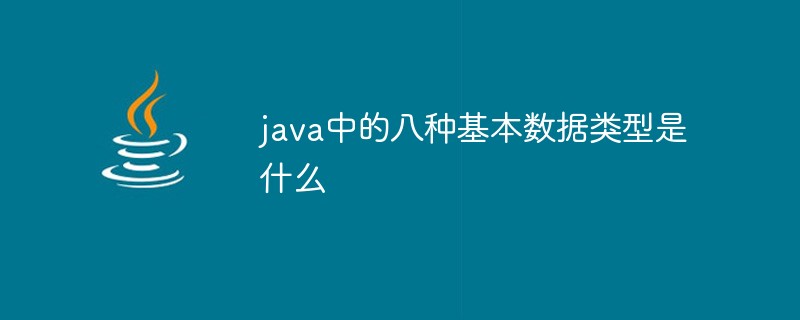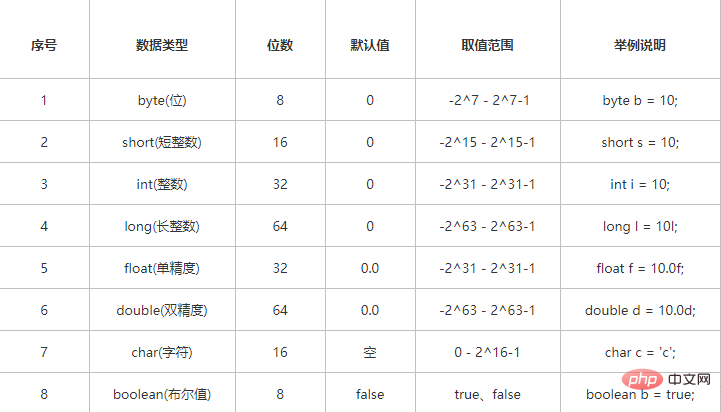
Die acht grundlegenden Datentypen in Java sind: 1. Byte 2. Int;

Die Betriebsumgebung dieses Artikels: Windows 10-System, Java 1.8, Thinkpad T480-Computer.
(Lernvideo-Sharing: Java-Video-Tutorial)
Detaillierte Einführung:
8 grundlegende Datentypen in Java, ihre Namen, Ziffern, Standardwerte, Wertebereiche und Beispiele werden in der folgenden Tabelle angezeigt:

Beispielüberprüfung:
package com.ce.test;
class Test {
static byte b;
static short s;
static int i;
static long l;
static float f;
static double d;
static char c;
static boolean bo;
public static void main(String[] args) {
System.out.println("byte的大小:"+Byte.SIZE
+";默认值:"+b
+";数据范围:"+Byte.MIN_VALUE+" - "+Byte.MAX_VALUE);
System.out.println("short的大小:"+Short.SIZE
+";默认值:"+s
+";数据范围:"+Short.MIN_VALUE+" - "+Short.MAX_VALUE);
System.out.println("int的大小:"+Integer.SIZE
+";默认值:"+i
+";数据范围:"+Integer.MIN_VALUE+" - "+Integer.MAX_VALUE);
System.out.println("long的大小:"+Long.SIZE
+";默认值:"+l
+";数据范围:"+Long.MIN_VALUE+" - "+Long.MAX_VALUE);
System.out.println("float的大小:"+Float.SIZE
+";默认值:"+f
+";数据范围:"+Float.MIN_VALUE+" - "+Float.MAX_VALUE);
System.out.println("double的大小:"+Double.SIZE
+";默认值:"+d
+";数据范围:"+Double.MIN_VALUE+" - "+Double.MAX_VALUE);
System.out.println("char的大小:"+Character.SIZE
+";默认值:"+c
+";数据范围:"+Character.MIN_VALUE+" - "+Character.MAX_VALUE);
System.out.println("boolean的大小:"+Byte.SIZE
+";默认值:"+bo
+";数据范围:"+Byte.MIN_VALUE+" - "+Byte.MAX_VALUE);
}
}Das Ausgabeergebnis auf der Konsole ist wie folgt:

Verwandte Empfehlungen: Java-Einführungs-Tutorial
Das obige ist der detaillierte Inhalt vonWas sind die acht grundlegenden Datentypen in Java?. Für weitere Informationen folgen Sie bitte anderen verwandten Artikeln auf der PHP chinesischen Website!